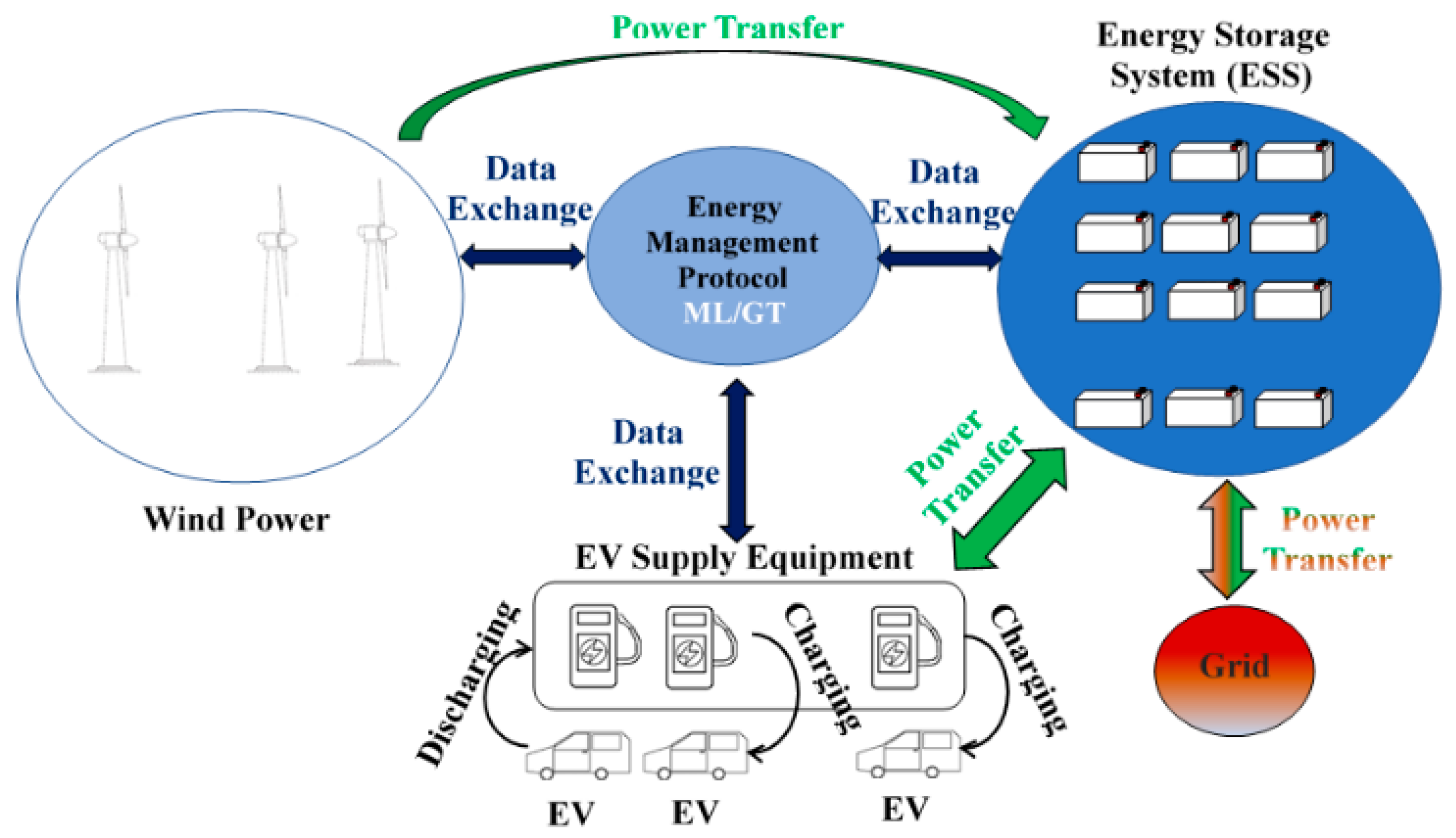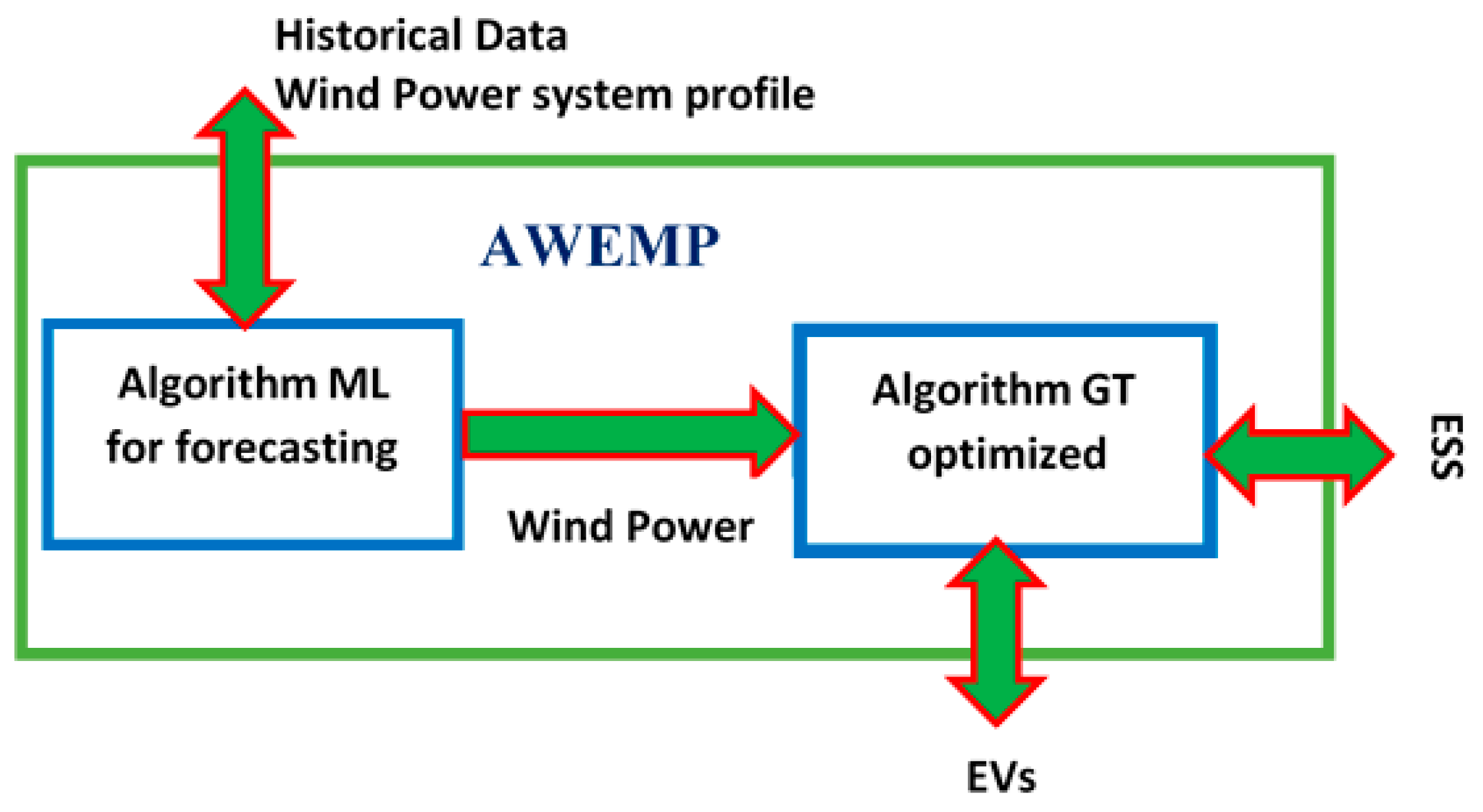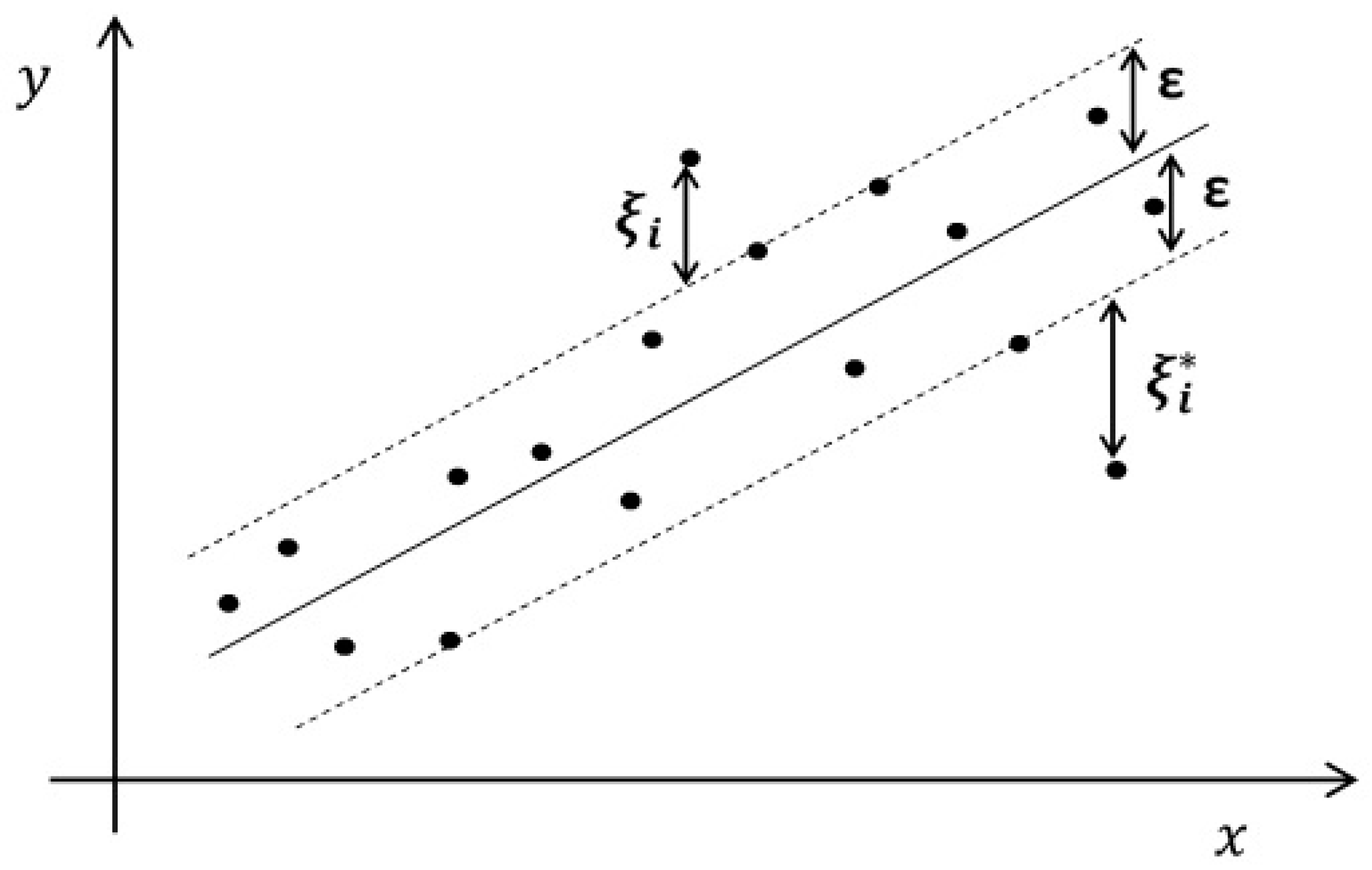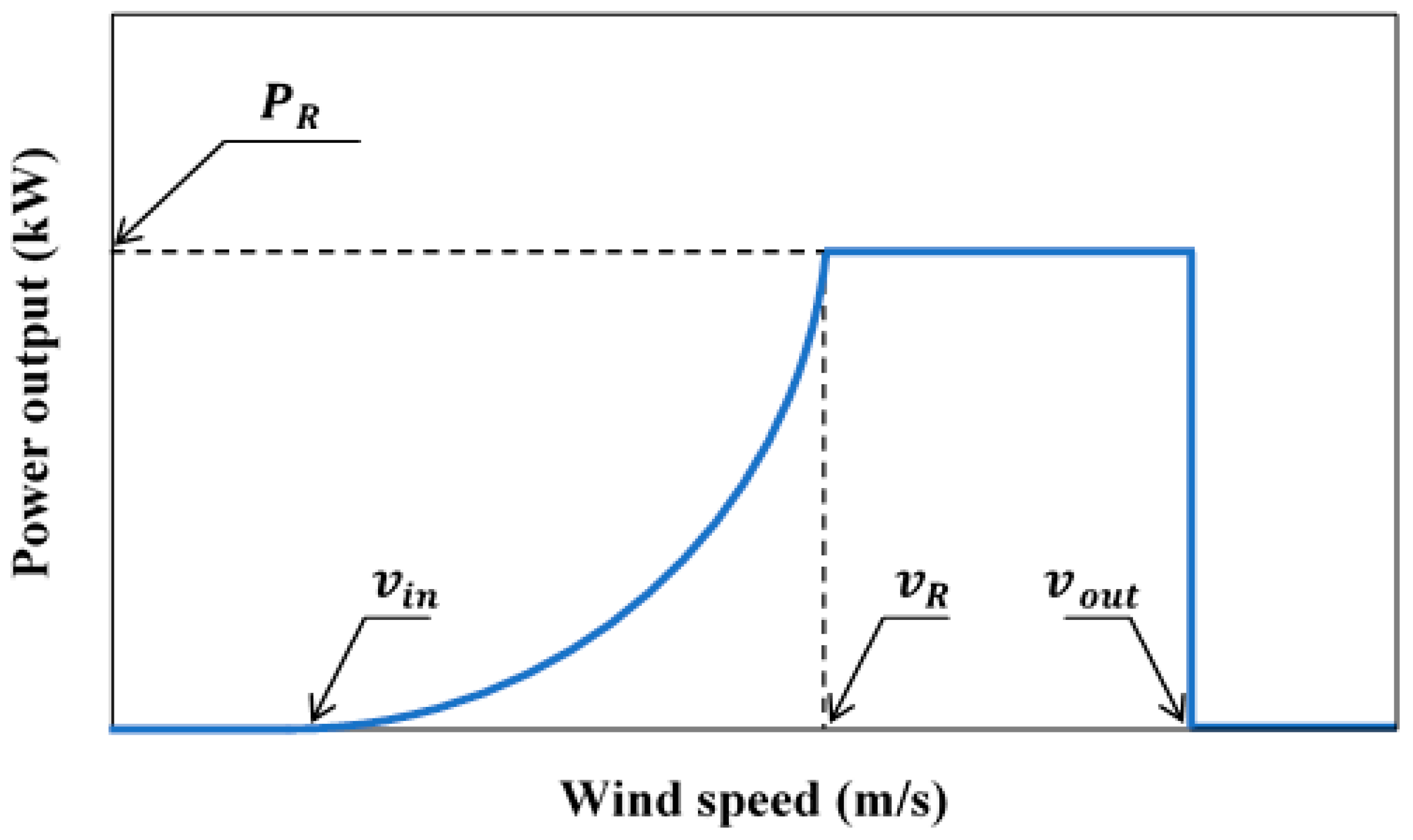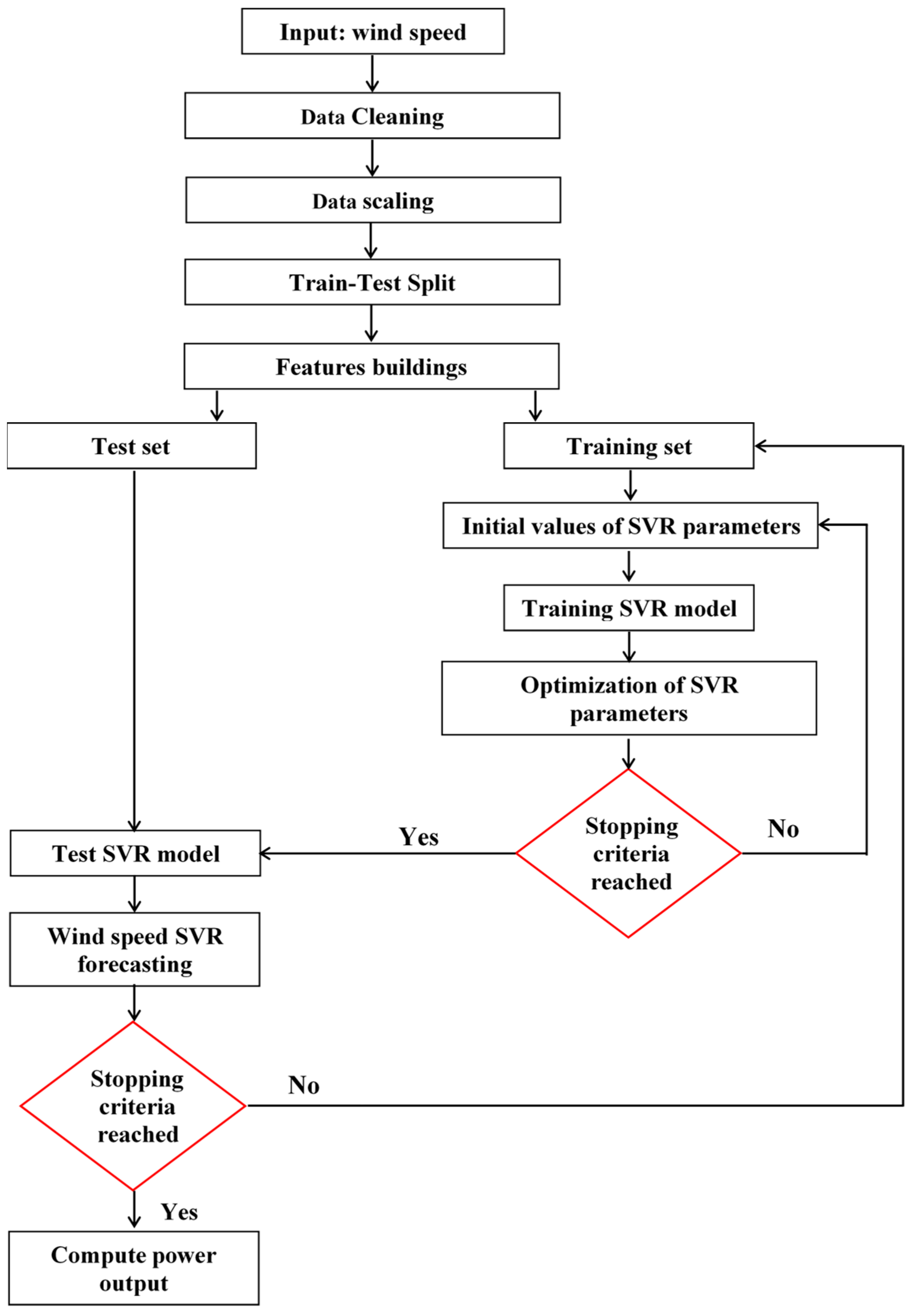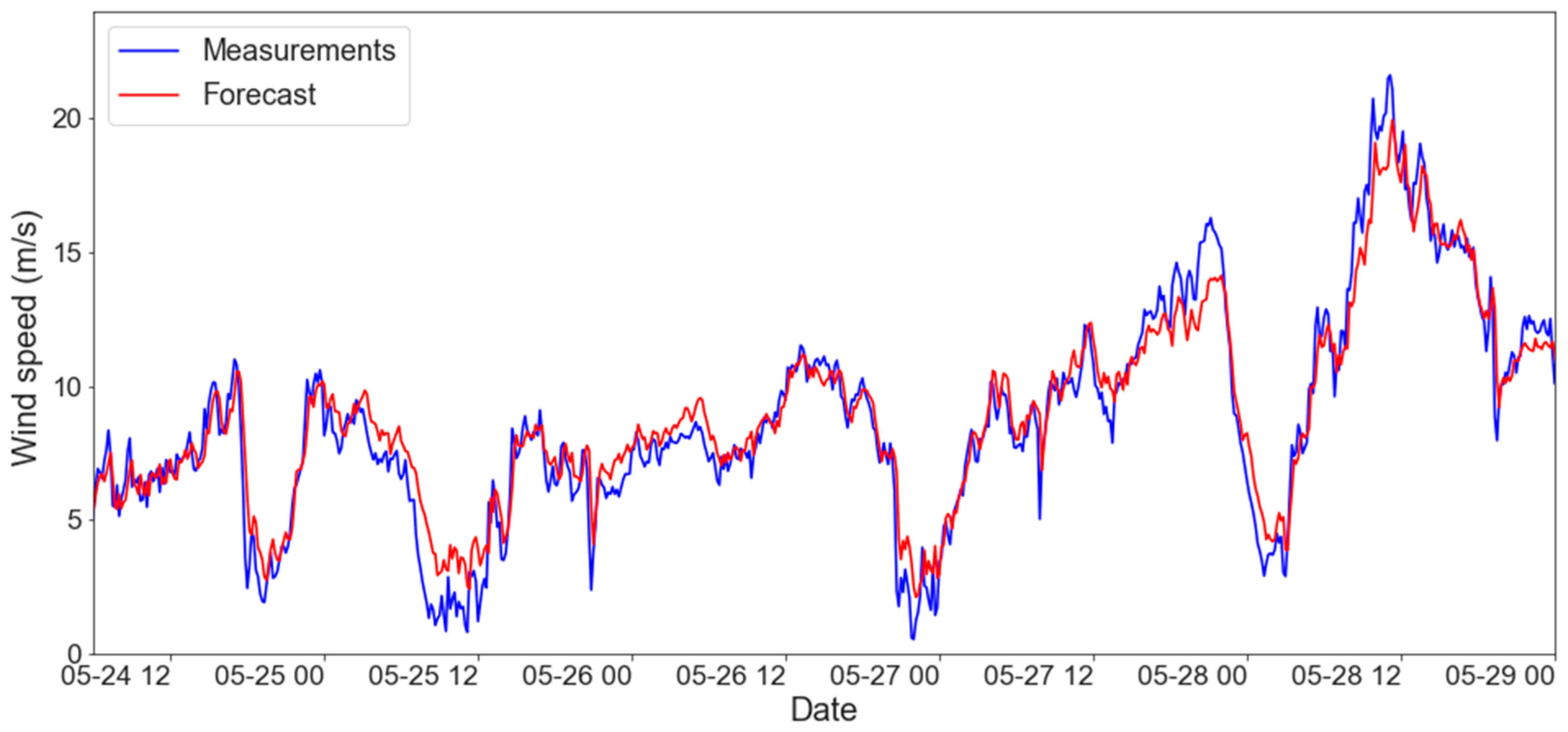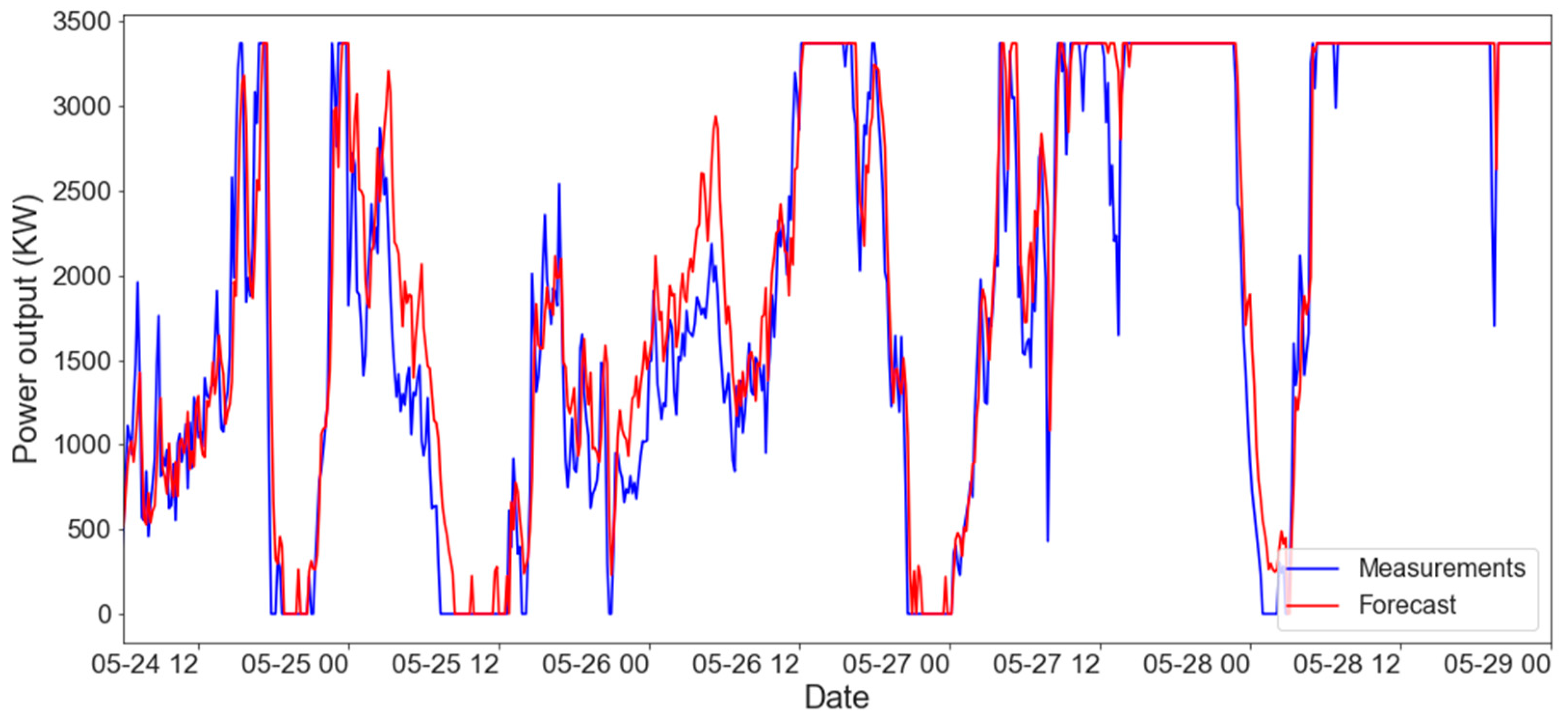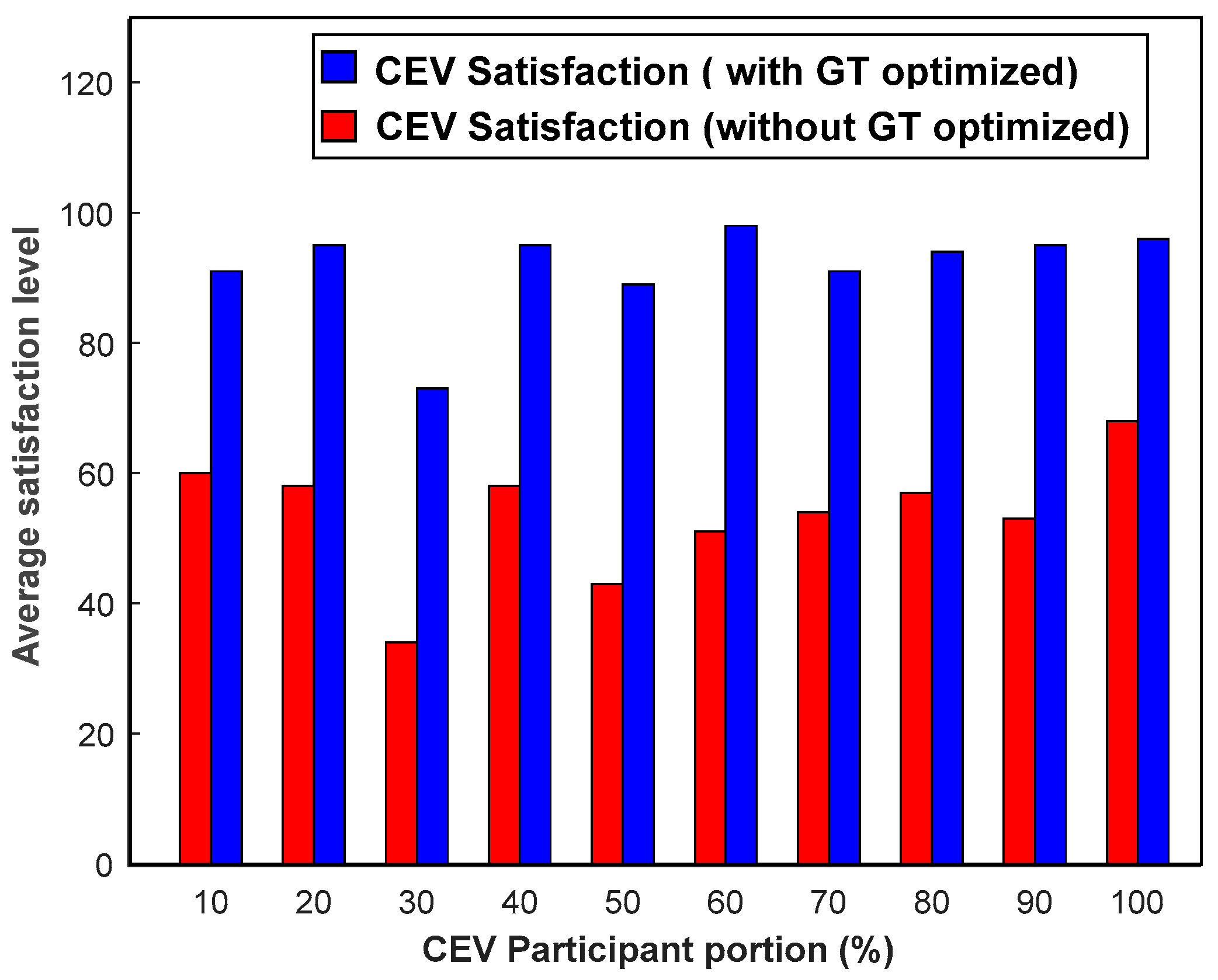1. Introduction
The way we use and consume energy is dynamically changing from day to day. This is to be aligned with the global objectives of COP 27, such as the energy transition revolution, GHG emission reduction, climate change commitments and the maximization of communities’ satisfaction regarding the energy service [
1]. From energy generation to storage, distribution and delivery, different management techniques based on the capabilities of Information, Communication and Technologies (ICTs) are used to tackle energy efficiency, especially in the context of smart grid infrastructure with a huge penetration of Electric Vehicles (EVs) and multiple renewable energy sources (RESs).
Wind power is one of the RESs that have undergone significant growth in installed capacity over the past two decades. It is becoming increasingly cost-effective, as it has the lowest carbon emission rate [
2]. According to the Global Wind Report, nearly 94 GW of wind capacity was installed in 2021. Similar to other RESs, from a commercial point of view, wind power systems are in an early stage. This is because the current wind power system lacks reliability and attraction in the market and needs further development to deal with its dependence on weather conditions [
3,
4], as well as the stochastic behavior of the load on the demand for power specifically caused by consumer behavior changes and the widespread adoption of EVs as an attractive mobility system [
5]. Thus, more uncertainties and constraints will put pressure on the power system [
6,
7]. Both wind power and EVs require the use of efficient and robust energy management procedures to deal with issues related to power generation, distribution and delivery.
For this reason, the energy management approaches designed for RESs in general, and for wind power specifically, are very challenging not only at the technical level of development and implementation but also in terms of environmental commitments and the energy transition paradigm, especially in the context of Net-Zero business development and COP27 requirements [
8,
9,
10,
11,
12,
13,
14]. Therefore, the integration of huge capacities of wind energy into the power system can result in several technical matters, such as the dispatch and regulation of power. To cope with these issues, wind power forecasting can help to perform optimal energy management depending on the predicted power that will be generated for a certain time horizon. However, wind energy forecasting is a difficult task, which raises concerns regarding the management and regulation procedures and integration methods in the electricity market. Furthermore, the uncertainties associated with connected EVs on the demand side and time-varying loads have led to new challenges for Distribution System Operators (DSOs) in reaching an equilibrium between demand and supply for the steady operation of the power system. Consequently, there is an increasing interest in developing an Energy Management Protocol (EMP) based on the more precise modeling and forecasting of wind power production for a variable load demand, where data forecasts and analysis are crucial elements for efficient energy operation and management commitments.
Depending on the method used, several investigations can be found in the literature on the development and use of an energy management system (EMS) [
8,
9,
10,
11,
12,
13,
14]. In [
8], the authors reviewed different aspects of the EMS with a complete analysis of the different stakeholders and partakers that can be involved in it. They presented a critical examination of the distributed energy resource performance and different plans in the EMS, along with a full analysis of the optimization techniques used to accomplish EMS goals under multiple constraints. They concluded their work by giving recommendations for an optimized EMS that can be used for different applications, such as EVs, industries, buildings and the total community. Another review paper on EMS approaches in microgrids can be found in [
9], where the authors provide a classification of the methods used for EMSs on the basis of the technique, configuration and control employed to preserve the balance between energy resources and accessible loads while adding benefits to their usefulness. In [
10], an Intelligent Smart Energy Management System (ISEMS) was proposed to administrate the load demand in a smart grid environment with the deep penetration of renewables.
An EMS was also used for smart grid and microgrid energy management in [
11,
12,
13], where different techniques were employed. For instance, the author in [
11] introduced smart microgrid (SMG) concept-based prediction techniques and highlighted the role of power generation and revenue forecasting methods to drive SMG deployment with the liberal power market idea, while the authors in [
12] proposed a new versatile EMS depending on the frequency, through which distributed generators have controllers with time-varying droop and a gain-adaptive strategy. The random planning of hybrid AC/DC microgrids considering plugin Hybrid Electric Vehicle (HEV) charging loads distributed all over the grid was investigated in [
13].
Wind energy management was studied in [
14,
15]. The authors in [
14] investigated the control and management of an unconnected wind energy system against variations in wind speed and demand load. In [
15], via a Model Predictive Control (MPC) controller and using an EMS, the authors solved the problem of optimization by taking into account production forecast data and handling several operation rules of a hybrid power plant (HPP) composed of a wind farm connected to the grid and a Li-ion battery storage system on the electrical grid of Guadeloupe Island.
Energy management systems were also used to optimize the powertrain design for fuel-cell batteries for EV applications by implementing a deep deterministic policy gradient [
16] and to analyze the effect of control factors and design factors on the dual source of power for the selection of the power battery capacity range considering the synergistic decline in the dual power source’s lifetime in the operating lifecycle of a fuel-cell vehicle [
17].
The above literature review shows how important the use of the EMS is in managing the growing energy needs of the modern power system and in coping with the problems introduced by RESs and EVs in the framework of the carbon-free emission target and climate neutrality by the year 2050. Nevertheless, the interactions between different participants, specifically EVs, in the presence of intermittent RESs, such as wind power, taking into account the free and competitive exchange between participants, need to be further investigated. For this reason, more attention should be paid to such situations where the management, trading and exchange of energy are carried out in a liberal and decentralized way between participants.
In this work, we present the development of an Advanced Wind Energy Management Protocol (AWEMP) for power distribution between a wind power source, the main grid, an ESS and an EV charging supply point based on the combination of ML and GT algorithms. The forecasting of wind power is performed using the ML model, namely, support vector regression (SVR); the ML model (SVR) choice will be validated in the next subsection. The GT model is used to increase the accuracy and efficiency of the power management process between participants. Technically, GT is used to solve problems arising from the complex interaction between participants (energy sellers and buyers) by adopting the cooperation and conflict GT schemes.
Our contributions in the present study are summarized as follows:
We are the first to consider combining ML and GT algorithms in the development of an AWEMP for power distribution between the wind power source, the main grid, an ESS and an EV charging supply point, where power transfer is two-way between all parts, except for wind power.
We formulated and developed the proposed AWEMP. The mathematical model reflects the concept of free and competitive exchange between the different participants in the system.
We prove that the AWEMP, which is based on ML and GT models, can successfully operate the EV charging and discharging demand process within the determined constraints and enhance grid stability when considering realistic EV charging/discharging characteristics.
The proposed AWEMP is effective and can be scaled for more complicated situations with different RESs and different parts on the demand side, taking into account a decentralized model of energy trading between participants.
The rest of this article is organized as follows. In
Section 2, we present several meticulously selected bibliographic works.
Section 3 presents the methodology and the approach adopted in this work. In
Section 4, we present the formulation of the problem and the system model. The main results and a discussion are presented in
Section 5. Finally, in
Section 6, we provide conclusions and future works.
3. Methodology
The approach adopted in the present work is a combination of ML and GT algorithms for the energy management of different parts: (1) the wind power source, (2) ESS, (3) electric vehicle supply equipment (EVSE) and (4) the main grid.
Figure 1 shows a graphic representation of the different intervening parts in the system.
Wind power represents the main source of energy. The energy harvested will be first stored in an ESS consisting of Li-ion batteries. The energy stored in the ESS is then used to charge CEVs through charging/discharging supply equipment. The ESS will also be connected to the main grid, so in the case of a lack of wind power, it can be supplied by the grid. At the same time, the ESS can supply energy to the grid when the generated wind energy exceeds the demand from EV supply equipment, and thus it can help reduce the peak load.
Power transfer will be bidirectional between the ESS and the main grid, as well as between the ESS and EV supply equipment, as shown in
Figure 1. This situation will allow all parts of the power system to exchange and trade energy with one another, which represents an ideal atmosphere to perform energy management in a context that will reduce dependence on fossil-fuel-based sources of energy, thus decreasing carbon emissions, and achieving the global carbon-free target for the year 2050, since it will minimize the demand from the grid.
The AWEMP will optimally dispatch power between participants according to the availability of the generated/stored energy and the variability of the load on the DS (charging/discharging EVs), allowing the maximum profit and satisfaction of participants.
4. System Model and Problem Formulation
The proposed AWEMP flowchart is presented in
Figure 2, which illustrates the workflow of the AWEMP: First, the measured wind data will be processed and introduced into the AWEMP. Second, ML for forecasting will make a prediction of the available wind power based on historical data, which will in turn be fed into the GT optimization model to optimize of the process of EV charging/discharging.
Thus, energy management is performed depending on the generated wind power and the available stored energy in the ESS, which is backed by the grid, to optimize the bidirectional energy exchange (charging/discharging) between EVs.
The proposed AWEMP is a combination of ML and GT algorithms to predict and optimize wind power generation and the charging/discharging process of EVs. The mathematical formulations of these two models are given in the following paragraphs.
4.1. ML Forecasting of the Wind Power Modeling Approach
The SVR model used to perform the forecasting of wind power uses a supervised ML algorithm, support vector machine (SVM), for approximation and regression. The mathematical formulation of the SVR optimization problem can be summarized as follows.
The training dataset of input–output pairs is defined as
, where
is the space of the input features,
, with dimension
d, the target variables are
∈
, and
n is the training data size. The ML model can be formulated as shown in Equation (1):
where
f is the approximation function,
w is the weight vector,
b is the bias term,
θ (
x) is a nonlinear mapping function and (·) denotes the dot product in
.
The optimization problem for SVR can be reduced to finding
w by minimizing Equation (2):
with the constraints in Equations (3)–(5):
where
and
are slack variables,
C is the penalization parameter of the error that is applied to control the trade-off between the regularization term and empirical risk, and
is equivalent to the function approximation accuracy placed on the training data samples [
20].
Figure 3 shows the SVR graphical representation in the case of one-dimensional linear regression, where the parameter
approximates the accuracy of the regression and the slack variables
and
refer to outliers, which will be considered errors in the regression.
Lagrange multipliers,
and
, are then introduced to solve the SVR minimization problem. Subject to the previous constraints, this leads to the following form:
where
K denotes the kernel function, which allows the mapping of input data to a space with a higher dimension. Then, linear regression in the space with a higher dimension corresponds to nonlinear regression in the original space. The kernel function could be a linear function, polynomial (Poly), radial basis function (RBF), exponential radial basis function (ERBF), or customized kernel function.
The validation of the results is achieved using the R-squared error (RSE), which is computed according to the following formula:
where
is a predicted value, and
is the average value of
values.
Once the forecasting of wind speed is performed and validated, the wind turbine power output is then computed according to Equation (8) [
32]:
where
is the wind speed,
is the cut-in wind speed,
is the cut-off wind speed,
is the rated wind speed,
is the rated power of the wind turbine and
is the actual output power of the wind turbine.
Figure 4 illustrates the relationship between the parameters in Equation (8), and it depicts the dependence of the wind power output on the wind speed. First, the wind turbine starts generating energy at a wind speed equal to
, and then the power output will increase exponentially until it reaches the value of
at the wind speed
. The power output will remain constant at
until the wind speed reaches the value
, where the power generation of the wind turbine has to be cut off for security reasons since the wind speed has reached high values that could lead to high-speed rotations, which will severely affect the operation of the wind turbine.
Table 1 summarizes the values of these parameters, which will be used to compute the power output of the wind turbine.
Wind power output forecasting is performed by solving Equations (1)–(8) according to Algorithm 1.
| Algorithm 1. ML for forecasting |
| Input: Training dataset |
| Output: Power output forecasting |
- 1.
Input data processing: finding anomalies within the input data, correcting them and replacing unusual measured values, - 2.
Data transformation: data scaling using mini-max scaler, - 3.
Training–test split for a certain input ratio, - 4.
SVR modeling: Fitting the SVR model with RBF kernel function to the training set and validating with the test set, - 5.
Feature building: Creating a feature set using data with a lag, - 6.
Forecasting of the wind speed using multistep feature forecasting based on the lagged data and the SVR model, - 7.
Validation of the results of performing the R2-error accuracy test, - 8.
Computation of from the forecasted wind speed.
|
The flowchart describing the details of the ML algorithm used for forecasting wind power is presented in
Figure 5. The ML model goes through different test criteria before it can be used to forecast wind power. This will provide enough confidence in the results of forecasting.
4.2. Optimization Problem with GT Model
The interaction between all parts of the whole system presented in
Figure 1 depends on battery storage management in the ESS and CEV system and their charging/discharging process. For the ESS, the instantaneous state-of-charge variation is linked to the grid, wind power and the charging/discharging procedure of CEVs in the corresponding supply charging. Thus, the ESS model can be presented by Equation (9):
where
SoCESS is the ESS state of charge,
SoCCh and
SoCDch are the states of charge of EVs scheduled for charging and discharging, respectively,
t is the time variation,
NCh is the number of the CEVs scheduled for the charging process,
NDch is the number of the CEVs scheduled for the discharging process and
M is the number of EVSE items in a region such as Ottawa.
For each CEV, the SoC variation is provided by Equations (10) and (11):
where
.
As the quality of service in the EVSE system is based on the satisfaction of the CEVs, the objective function of the whole system can be written as
subject to
where
CT is the total cost of the wind power system, and
is the power needed from the grid.
The charging/discharging problem is considered in the objective function given by Equation (12). The optimal solution maximizes CEV satisfaction, whatever the service needed (charging or discharging), while minimizing the cost of the wind power system and the support of the grid. This model is based on a competitive approach, such as Nash equilibrium with the Stackelberg game scheme [
31].
The validation of the results is performed by computing the Root Square Mean Error (RSME) according to the following Formula (14):
We propose the Algorithm 2 to resolve Equations (9)–(14).
| Algorithm 2. GT optimization |
| Input:NCh, NDch, M, CEV profiles, charging/discharging rate; wind power, ESS capacity |
| Output: CEV satisfaction |
- 1.
CEV declares the electricity quantity that it needs or is ready to sell, as well as the timing range and its expected electricity price, - 2.
According to the electricity price variation, the EMP schedules each CEV (for the charging or discharging process) and updates all data received, /* */ - 3.
Resolve Equations (9)–(14), - 4.
Update the number of CEVs satisfied.
|
5. Results
Wind measurements were gathered in the framework of a wind power assessment project. A mast was installed in a site located in Utique in the governorate of Bizerte in the north of Tunisia, which is an uninhabited mountainous agricultural region with an altitude of about 343 m. The mast acquires 10 min measurements of the wind speed, temperature, pressure, humidity and wind direction at different heights for the assessment and control of wind power.
The measurements taken over one year were preprocessed and then used to train the ML algorithm, namely, the SVR model. The SVR model hyperparameters and the training–test proportions were optimized through the cross-validation method according to the flow chart in
Figure 4. The RBF was selected as a kernel for the SVR model, as it has shown an exceptional ability to model the nonlinear behavior of wind measurements [
20,
21,
22].
The SVR model showed an excellent capability of wind speed forecasting for days ahead. The forecasted wind speed was then used to calculate the wind turbine power output, whose characteristics are summarized in
Table 1.
Figure 6 shows the measured velocity (in blue) with the forecasted wind speed (in red). The ML algorithm demonstrated good performance in terms of wind speed forecasting, especially for days ahead. The calculation of the RSE, based on measured and forecasted wind speed, gives us a result of about 0.94, which indicates that the prediction fits the measurements well.
Similar results can be found in [
21,
22], where, in both papers, the authors found accurate results using SVR based on RSEs of about 0.9999 for a 10-min horizon and 0.9883 for a time of 3 h, respectively. In our case, the calculation of RSE gave a value of 0.94, which is a little lower than the results in [
21,
22] since our time horizon was extended to up to 7 days ahead, while in their studies, the time horizon was limited to a few hours.
Once the wind speed is well forecasted, the wind power can be computed from the wind speed using Equation (8). The results of the computed wind power from measured and forecasted wind speeds are presented in
Figure 7. The forecast appears impeccable, as it has captured the shape of the power output profile very well.
The RSE computed from the measured power output and forecasted output gives a value of about 0.88. Although this value is lower than the one found in the case of wind speed forecasting (0.94), it remains high enough to be confident in the results of the forecasted wind power outputs.
The decrease in the value of the RSE computed from the wind power output compared to the one computed from the wind speed is due to the fact that wind power is related to the wind speed to the power of 3 (Equation (8)); consequently, a small error in the wind speed could lead to larger one when computing the power output of the wind turbine.
The objective of the forecast should be very carefully established from the beginning. It can be considered a technical as well as a strategic question. The deviation between the measured values and forecasted ones should be treated carefully, as it can lead to more discrepancies in tasks such as energy trading or decision making by DSOs.
Consequently, properly estimating the accuracy of the forecasts defined in
Figure 5 can significantly increase the value of energy. That said, energy trading can be well conducted in certain markets when appropriate trading strategies are used (such as peer-to-peer energy trading between participants based on a blockchain and smart contacts [
31]) while at the same time helping DSOs to balance the power system.
Considering the system presented in
Figure 1 and having the power output from wind, we conducted 1000 runs of simulations, and then the Monte Carlo technique was used to extract the average values for each setting. The simulations were performed using MATLAB. To prove the performance of our proposed scheme, we simulated the satisfaction level of CEVs regarding the charging and discharging service. We define the satisfaction level as the number of CEVs completing the charging or the discharging process divided by the total number of CEVs in each EVSE.
Table 2 shows our simulation parameters.
The GT model is considered to make the best decision possible given how energy participants interact using the EMP, especially where goods (electricity) are divided between competing goals.
Figure 8 compares the CEV satisfaction level with (represented by the blue color) and without our GT optimization algorithm (shown by the red color). It is obvious that our GT optimization algorithm improves the average CEV satisfaction.
From
Table 3, we can conclude that these results demonstrate that our GT optimization algorithm increases CEV satisfaction by more than 44%.
Several papers have reported using GT models to improve the charging/discharging process of EVs in different situations [
34,
35,
36]. It was shown that using GT approaches can improve the planning of en-route charging station locations and maximize subsidies toward the purchase of charging units by up to 14.3% in [
34], while in [
35], the proposed GT-based strategy outperformed the benchmark strategies in terms of overall profits.
The authors in [
35] proposed a decentralized GT (D-GT) model aiming to optimize the EVs’ interaction with the D-EVSE considering both EVs’ satisfaction as well as the D-EVSE’s stability. Their results showed that the proposed model can manage and control the interaction between EVs and D-EVSE efficiently and effectively.
A comparison of the present work results and those in the literature [
34,
35,
36] shows that ours are in agreement with previous publications, as GT has improved, in terms of the satisfaction, profitability and reliability of the EV charging/discharging process. In fact, the use of the GT model helped improve the management of the charging/discharging process of EVs, showing an increase in the rate of EV satisfaction of up to 44% (
Table 3).
6. Conclusions and Discussion
In this paper, a new AWEMP is presented and tested for RES management. Additionally, the role of forecasting models of power based on ML and GT is highlighted to deal with the natural variability of wind power generation to maintain energy system availability, sustainability and effectiveness.
The use of the GT optimization model improved the rate of satisfaction of CEVs in terms of the charging/discharging process. The combination of the ML algorithm and the GT model shows its performance in making the AWEMP more efficient and reliable. Simulations were conducted for forecasting and the optimization process to highlight how participants interact with the AWEMP, particularly where goods (electricity) are divided between competing goals.
The ML model showed a good capability of wind speed and wind power forecasting, as it effectively captured the profile of the power generated. Nevertheless, forecasting models for wind energy systems need much more attention to make the energy transition align with the best use of public and private RESs, deliver improvements to citizens’ quality of life and reduce energy costs [
11]. A small deviation between the measured values and forecasted ones could lead to more discrepancies in tasks such as energy trading or decision making by DSOs.
To perform perfect energy management, it is necessary to have information not only on the consumption profile on the demand side but also on the power generated for different time horizons (ultra-short, short, medium and long terms), particularly for intermittent and random sources of energy such as wind power, where variation in weather conditions could significantly alter power production.
The ML algorithm used in the present study is an effective and accurate model only in short- and medium-term forecast time horizons [
20]. For this reason, more investigations in the wind power forecasting domain are needed to achieve multiobjective forecasting, i.e., for different time horizons, and to cope with the uncertainties and intermittence in the generated power, as well as with fluctuations and randomness on the demand side. Future works are planned in which hybrid AI algorithms will be used for the multiobjective forecasting of wind power, as the use of hybrid AI algorithms has shown better performance in wind power forecasting compared to a single AI algorithm [
25].
The present AWEMP has shown great performance in managing interactions between participants when the energy transfer is bidirectional. This prompts a call to proceed to the next steps of investigation to perform decentralized energy trading based on the concept of the present AWEMP in future work.
